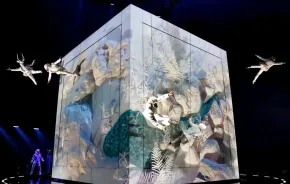Sandcastles on the Sound
2021 N.W. 190th St., Shoreline
206-418-3385
Richmond Beach Saltwater Park
offers breathtaking views of Puget Sound, short kid-friendly view
trails along a high bluff and a driftwood-strewn beach perfect for
imaginative play and walking.
History:
The Coast Salish used the area as a camp, for digging clams and for
gathering wild berries and a tobacco-like plant called q'q'e'waide
(k-eh k-EH wai dut), but by the early 1900s, the Great Northern
Railroad owned the beach land. The little community of Richmond Beach,
which became famous for the delicious strawberries grown on the
five-acre farms that comprised much of the area, was developing on the
bluff during this time. The Richmond Beach Sand and Gravel Company
began operation on the beach, sluicing the sand and gravel hill just
east of the beach with huge fire hoses. The base of the bluff was a
gravel pit with bunkers into which the gravel was sorted by size. The
sand that remained formed the present-day sandy strip of the beach. The
beach served as a loading area for the barges that carried away the
sorted gravel, and the wooden dock (now long gone) was a popular
fishing spot for local children. During the 1930s and early 1940s,
Richmond Beach was a funeral pyre for many outdated large ships. The
vessels were dramatically run aground, soaked with oil and set afire.
Steel survived the blaze and was salvaged for reuse.
In 1959, the Great Northern Railway sold the land to King County, which
developed the 37-acre property into a swimming beach and built a foot
trestle overpass for safely crossing the railroad tracks. Richmond
Beach became part of the City of Shoreline in 1994, and in 1995 King
County began the process of passing ownership of the park to the city.
Features:
A paved _-mile loop trail along the bluff starts directly past the park
entrance and leads to several benches and two large madrona trees. The
main road winds down the hill from the entrance past an upper terrace
with picnic tables. A second terrace farther down the hill features
many more picnic tables--some covered--plus barbeque grills and a small
play structure. At the bottom of the road, a short path through a tiny
wooded area leads to a wide, well-fenced overpass above the train
tracks. Trains pass below frequently and the bird's- eye view is
thrilling. Richmond Beach is rocky along the shoreline but features a
wide sandy strip perfect for sand castles. Since the beach area itself
is remote, parents may be wise to make this a group outing on all but
the sunniest days when beach fans pack the park. Look for the bronze
Coast Salish Welcoming Figure and a marker identifying geographical
features visible across the Sound. There are bathroom facilities on the
beach.
Access:
The play structure has an accessible path from the parking lot and curb
cut access. The beach can be reached without using stairs but the path
is steep. There is a drop of several inches at both ends of the train
track overpass where path meets ramps.
Nearby:
Picnic supplies are available at Richmond Beach Foods (2002 N.W. 196th
St., 206-546-1944). The Wild Horse (2001 N.W. 195th St., 206-542-5000)
offers burgers and ice cream at a walk-up window on the road down to
the beach. The Richmond Beach Coffee Company (1442 N.W. Richmond Beach
Rd., 206-542-0511), housed in an old auto-repair shop, offers
interesting teas. Full Moon (1441 N.W. Richmond Beach Rd.,
206-542-5777) features delicious Thai food and fast service for a
take-out dinner on the way home. The Richmond Beach Branch of the King
County Library (19601 21st Ave. N.W. 206-546-3522, www.kcls.org)
has a lovely children's area guarded by a touchable bronze raven. More
sculptures are scattered around the building's exterior. If possible,
visit the Shoreline Historical Museum (749 N. 175th. 206-542-7111, www.shorelinehistoricalmuseum.org).
Housed in the circa 1912 Ronald Elementary School, the museum
collection includes a room full of antique radios, a re-created period
schoolroom, a display about the now-vanished Playland Amusement Park
and many other fascinating artifacts of Northwest life from the 1890s
on. The building is accessible via ramp and elevator.
Paula Becker is a contributing editor for www.HistoryLink.org and a mother of three.









